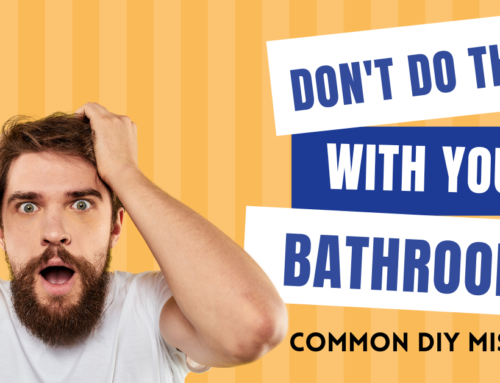When it comes to shower tile leaks, the signs of damage often go unnoticed until the problem has already become serious. At Allspex Tiling, we get calls every week from homeowners asking us to come and replace ‘just a cracked shower tile’. But in wet areas, it’s not that simple. Cracked tiles, discoloured grout, and musty smells are all signs that water has already gotten underneath your tiles and potentially compromised the waterproofing. If degraded grout allows water to get under your tiles, you’d better seal it fast. But once the waterproofing membrane fails, a shower seal is no longer a solution. Here’s how to recognize the warning signs of serious shower tile damage and why proper repair is essential to prevent further water damage to your property
Why Water Damage Under Tiles is a Big Deal
Water is your shower’s biggest enemy, and it doesn’t take much for it to find its way underneath your tiles. Over time, even small cracks or deteriorated grout lines can allow moisture to seep in. When water reaches the layer beneath your tiles, it starts to compromise both the adhesive holding the tiles in place and the waterproofing membrane that protects your home from damage.
Once this layer is affected, water can spread unnoticed, leading to serious issues such as:
- Mould and mildew growth
- Structural damage to subflooring or walls
- Expensive repairs to fix extensive water damage
By the time you notice visible signs of shower tile damage, the water has likely been there for a while, slowly breaking down the integrity of the waterproofing system. That’s why understanding the warning signs is critical.
Key Warning Signs of Shower Tile Damage
Here are the top signs that your shower tiles are already compromised:
1. Cracked or Loose Tiles
Cracks in your tiles might seem like an isolated issue, but they often point to a deeper problem. Water may have seeped underneath the tiles, loosening the adhesive that keeps them in place. You might also notice that tiles feel loose or wobbly when you step on them, a clear sign that water damage has affected the bond between the tile and the surface beneath it.
2. Discoloured or Crumbling Grout
Grout is meant to keep water out, but when it becomes discoloured, cracked, or starts crumbling, it’s no longer doing its job. Water can seep through these cracks and spread underneath the tiles. You might see dark or black spots, which are usually signs of mould caused by moisture build-up beneath the tiles. Once grout is compromised, the integrity of your shower is at risk.
3. Water Stains on Adjacent Areas
If you see water stains on walls or ceilings adjacent to your shower, that’s a major red flag. This indicates that water is escaping the shower area and leaking into other parts of your home. By the time these stains appear, water has likely been leaking for some time, and the tiles and waterproofing are already compromised.
4. Musty or Damp Smell
If your bathroom has a persistent musty smell that doesn’t go away with cleaning, it’s likely a sign of hidden water damage. This smell is often caused by mould or mildew growing behind the tiles where water has been trapped. Ignoring this odour can lead to serious health risks, especially for people with allergies or respiratory issues.
5. Drummy Tiles
Drummy tiles make a hollow sound when tapped, indicating that they’ve detached from the surface beneath them. This is often caused by water getting underneath the tile, loosening the adhesive, and creating a gap. Drummy tiles are a clear indication that the waterproofing has been compromised and the tiles are no longer securely bonded to the floor or wall.

When your shower’s tiles start to look discoloured like this, it means the grout is no longer doing its job to keep the water out. In cases like this shower where tiles are small, there are too many grout lines to make sealing worth it. It will take a long time, cost you a lot and there’s no guarantee it will work if the problem runs deeper.
Why Sealing Your Tiles Won’t Solve the Problem
When homeowners or property managers notice these issues, they’re often led to believe that a simple fix is to seal the tiles and the leak will dry up. While regrouting and sealing shower tiles might seem like a more affordable solution, it’s only a surface-level fix that won’t address the underlying water damage.
Here’s why sealing alone won’t solve the problem:
Sealing Doesn’t Fix Compromised Waterproofing
Once water has penetrated beneath your tiles, if it’s left for too long, it degrades the waterproofing membrane. Sealing the surface may prevent more water from getting in temporarily, but it does nothing to remove the water that’s already causing damage underneath. Over time, the trapped moisture will continue to erode the adhesive and substrate, leading to even more extensive damage.
It’s Only a Temporary Fix
Even if a sealant holds for a short period, it’s not a permanent solution. The water beneath the tiles will eventually cause the seal to fail, leading to the same problem again in just a few months. At that point, you’ll likely need more extensive (and expensive) repairs.
Mould and Mildew Can Still Grow
Sealing over existing moisture won’t stop mould and mildew from growing. In fact, it can trap moisture and create the perfect environment for these harmful fungi to thrive. The longer mould and mildew are left unchecked, the more dangerous they become for your health and the harder they are to remove.
Rotting Timber Structures
Once moisture penetrates through to the timber behind your tiles, it can begin to rot the wall structure or, even worse, the timber subfloor. In these cases, you may be looking at costly timber repairs. The situation becomes even more dangerous if you have a shower on a higher storey. Standing on rotting timber in a leaky shower creates serious safety risks that no amount of sealing can fix.
In short, sealing may buy you some time, but it’s not a solution to the underlying issue of water damage. Proper tile repair and waterproofing are the only ways to ensure long-term protection
The Real Solution: Repairing Waterproofing
When your shower tiles show signs of damage, the real solution is to remove the affected tiles, assess the underlying damage, and reapply the waterproofing system. Here’s what a proper repair process looks like:
-
Tile Removal
The first step is removing the damaged tiles to assess the extent of the water damage underneath. This allows professionals to determine how far the moisture has spread and which areas need to be re-waterproofed. In many cases, you can save yourself cost by just removing the floor and bottom row of wall tiles as most leaks arise in the base of the shower. Just be mindful that if aesthetics are important to you, you’ll need to find a close match for your existing wall tiles.
-
Waterproofing Repair
Once the damaged tiles are removed, the next step is to repair or replace the compromised waterproofing membrane. This is a crucial step that ensures no further water damage will occur. A qualified tiler will apply a new waterproofing layer to protect your home from future leaks. At Allspex Tiling, we apply two coats for added security, and use a layer of reinforcement mesh bandages that integrate into the membrane to ensure no moisture can seep through to the cement bedding.
-
Tile Replacement and Regrouting
After the waterproofing is restored, cement bedding is mixed and poured to ensure the floor slopes correctly to the drain and then new tiles can be laid. Then the area will be regrouted to ensure a watertight seal. It’s vital that you use a tiler with experience in wet areas who doesn’t skimp on spending for high-quality products. Not all tilers opt for epoxy grout because it sets quickly and can be tricky to work with, but epoxy is unmatched in defending against shower leaks. That’s why we insist on grouting wet areas with epoxy and stand by our FlexiShield™ sealant with a 15 year warranty.
Why Qualified Tilers Are Essential for Lasting Repairs
Shower tile repairs are not a job for amateurs. A qualified tiler understands the complexities of waterproofing and knows how to properly diagnose and fix the underlying issues. Many sealing technicians offer quick fixes but don’t have the qualifications to understand what’s happening beneath the tiles. Shower repair companies often don’t even have a licensed tiler on staff – do you want to trust them with your property after learning the damage that water can cause?
Conclusion
If you’ve noticed any of the warning signs of shower tile damage—cracked tiles, discoloured grout, drummy tiles, or musty smells—it’s time to take action. Ignoring these signs or opting for a temporary seal will only lead to bigger, more expensive problems down the road. The best way to protect your home from water damage is to address the root cause and have your shower tiles professionally repaired.
Contact Allspex Tiling today for a thorough assessment and expert repair services. Our team of licensed professionals is here to give you honest, no-bull answers, and solutions that will give you long term peace of mind.






